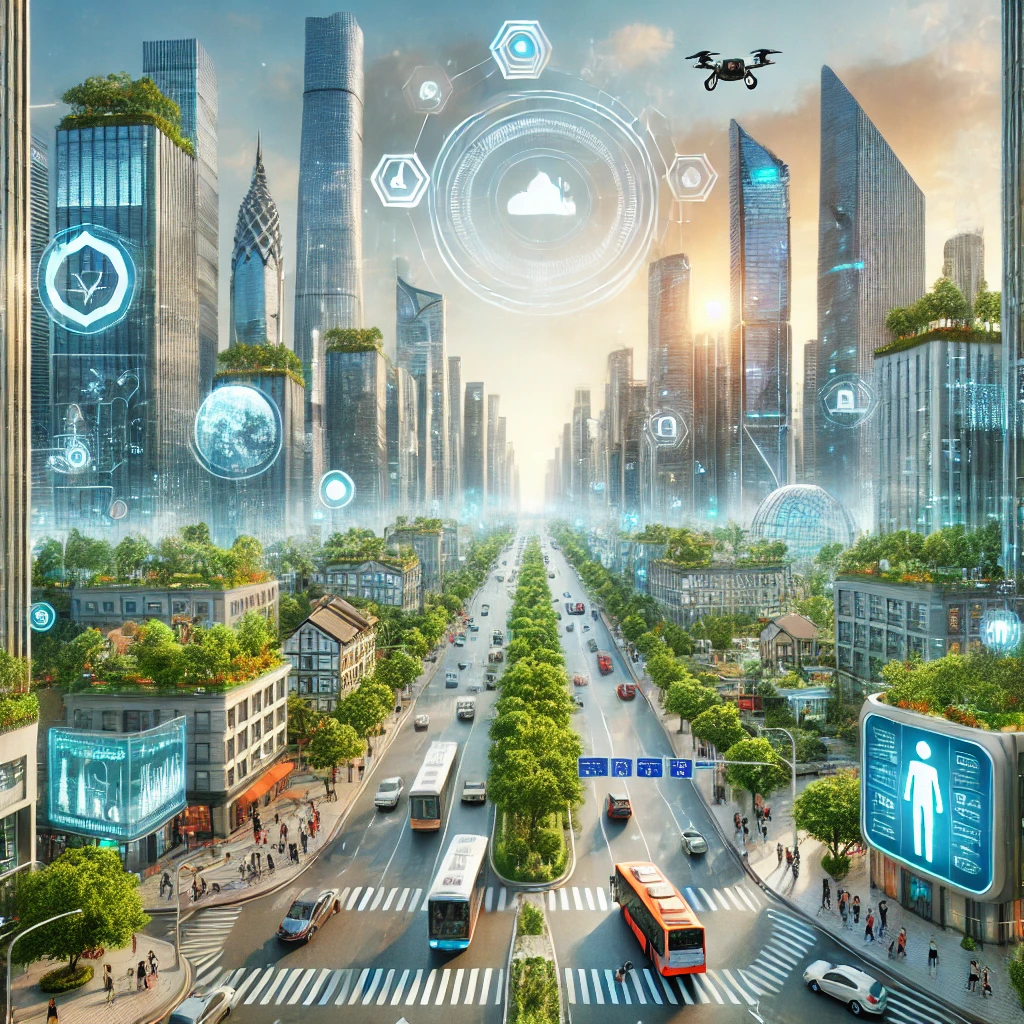Table of Contents
Introduction to Smart Cities
Smart cities represent a transformative approach to urban living, integrating advanced technologies into the fabric of city infrastructure to enhance the quality of life for residents. By leveraging the Internet of Things (IoT), big data analytics, and artificial intelligence, smart cities aim to create environments that are not only efficient but also sustainable and responsive to the needs of their inhabitants. These urban areas utilize interconnected systems and devices that facilitate real-time data collection and communication, empowering city officials to make informed decisions and improving the overall functionality of urban services.
The concept of smart cities encompasses various dimensions, including energy management, transportation systems, waste management, and public safety. For instance, by utilizing smart grids, cities can optimize energy consumption and reduce carbon footprints while ensuring a reliable energy supply. Furthermore, smart transportation solutions, such as traffic management systems and shared mobility options, have the potential to alleviate congestion and minimize travel time for residents. In this context, smart cities are not just about technology; they form the backbone of a holistic approach aimed at fostering sustainable urban development.

China’s Urbanization Challenge
China is undergoing one of the most significant urbanization processes in contemporary history, with more than half of its population currently residing in urban areas. This swift transition from rural to urban living presents an array of challenges. Overpopulation in major cities such as Beijing and Shanghai has led to severe pressure on infrastructure and services, resulting in inadequate housing, congested transportation systems, and limited public resources. The rapid influx of people has made effective urban planning increasingly complicated, as the traditional systems often fail to meet the demands of an expanding populace.
Moreover, environmental pollution has become a critical issue, exacerbating health concerns and diminishing the quality of life in urban areas. As industries proliferate and vehicle usage rises, air quality in many cities has reached alarming levels. Water pollution further complicates the situation, with many urban dwellers having limited access to clean water. Addressing these environmental challenges is essential for sustainable urban living, highlighting the urgent need for innovative solutions.
Beyond ecological dilemmas, inefficient resource management poses an additional hurdle. Cities are challenged to optimize the use of energy, water, and waste management systems amidst rapid growth. This inefficiency not only strains city budgets but also undermines efforts to create livable and sustainable urban environments. Consequently, the Chinese government has recognized that traditional methods are insufficient to meet modern urban demands. In this context, the investment in smart city initiatives is not just a strategy for modernization; it is a fundamental approach to alleviate the challenges posed by rapid urbanization. By incorporating technology into urban planning, China aims to create integrated systems that improve quality of life while minimizing environmental impact, thus paving the way for a more sustainable future.
Key Technologies Driving Smart Cities
China’s urban landscape is evolving rapidly, largely due to the integration of various advanced technologies that are defining smart cities. Central to this development is the Internet of Things (IoT), which connects a vast array of devices and sensors throughout urban environments. These connections enable real-time data collection and analysis, facilitating improved resource management, traffic control, and public safety. For instance, smart traffic lights that adapt to real-time traffic conditions help in reducing congestion and enhancing mobility within the city.
Another pivotal technology is Artificial Intelligence (AI). AI-powered systems are transforming how cities operate by automating processes and optimizing services. From predictive maintenance of infrastructure to intelligent waste management systems, AI enhances efficiency and saves costs. Moreover, AI algorithms can analyze historical trends and current data to predict urban challenges and find sustainable solutions, making cities more responsive to their inhabitants’ needs.
Big data analytics also plays a significant role in the development of smart cities. The vast amounts of data generated from various sources—such as IoT devices, citizen feedback, and social media interactions—are analyzed to derive insights that inform urban planning and policy-making. For example, urban planners utilize data analytics to identify areas requiring infrastructure improvement, ultimately leading to better living conditions for residents.
In addition to these technologies, the integration of renewable energy sources is crucial in promoting sustainability in smart cities. Solar panels, wind turbines, and smart grids contribute to reducing carbon footprints and ensuring that urban energy consumption aligns with environmental goals. The emphasis on green technology not only supports efficient energy use but also encourages a healthier living environment.
Through the harmonization of these technologies, the vision of smart cities in China is becoming a tangible reality, paving the way for a sustainable and efficient future of urban living.
Showcasing Leading Smart Cities in China
China has emerged as a leader in the development of smart cities, with several key urban areas implementing innovative technologies and initiatives. Among the most noteworthy are Shenzhen, Hangzhou, and Songdo, each showcasing distinctive advancements that illustrate the potential of urban living in the modern age.
Shenzhen, often referred to as China’s Silicon Valley, is renowned for its rapid transformation from a fishing village to a bustling metropolis. The city has integrated advanced technologies across various sectors, including transportation, energy management, and public safety. A noteworthy initiative is the deployment of an extensive electric bus system powered by cutting-edge battery technology, which has significantly reduced carbon emissions and improved air quality. Additionally, Shenzhen has embraced smart traffic management systems that utilize real-time data to optimize traffic flow and minimize congestion, ultimately enhancing the overall commuting experience.
Similarly, Hangzhou has distinguished itself with its pioneering digital governance efforts. The city has introduced an intelligent platform known as “City Brain,” designed to streamline city operations using big data analytics. By leveraging real-time information, this platform assists in traffic management, environmental monitoring, and public service efficiency. Hangzhou has also invested in smart kiosks, allowing residents access to various services, thereby improving administrative efficiency and citizen engagement.
Songdo, although a planned city located within South Korea, represents an integral part of China’s smart city narrative due to its influence on the regional development. Songdo incorporates a comprehensive set of smart technologies, from integrated waste disposal systems to enhanced public accessibility through smart transportation. The synergistic approach adopted in Songdo serves as a model for urban planners across China.
These cities exemplify how targeted initiatives and cutting-edge technologies are shaping the future of urban living in China. They highlight the potential of smart cities to address urban challenges, enhance the quality of life for residents, and pave the way for sustainable urbanization practices.
The Role of Government and Policy
The development of smart cities in China is significantly influenced by government initiatives and strategic policies. The Chinese government has recognized the importance of integrating technology and sustainability into urban planning, which has resulted in a comprehensive framework aimed at enhancing urban living conditions. By outlining clear objectives and investment strategies, authorities have paved the way for sustainable development within these urban areas.
One of the primary mechanisms for funding smart city projects is through national and local government budgets, supplemented by public-private partnerships. These collaborations harness the expertise and resources of the private sector, facilitating the deployment of advanced technologies such as the Internet of Things (IoT), big data analytics, and artificial intelligence. This multifaceted approach not only draws essential funding but also fosters innovation, creating a conducive environment for tech-driven solutions that address urban challenges.
Furthermore, the Chinese government has established regulatory frameworks that provide guidelines for smart city initiatives. These regulations ensure that projects align with broader national goals, such as environmental sustainability and enhanced quality of life for residents. Local government authorities play a crucial role in adapting these policies to their specific contexts, which results in tailored strategies for each city’s unique challenges and opportunities. This localized approach enhances the efficacy of urban planning and implementation, leading to the creation of smart cities that are not only technically advanced but also socially responsive.
Chinese leaders are also increasingly aware of the implications of their involvement in smart city development. They recognize that sustainable urban growth can lead to improved economic performance, higher living standards, and better environmental outcomes. As such, government engagement is not merely political posturing; rather, it is an essential component that underpins the successful realization of smart city visions across the country.
Challenges and Criticisms of Smart City Initiatives
As the concept of smart cities continues to gain traction in China, a multitude of challenges and criticisms arise from various stakeholders. One of the primary concerns involves privacy. The integration of advanced technologies, such as surveillance cameras and IoT devices, raises significant questions regarding data collection and the safeguarding of citizens’ personal information. Critics argue that the implementation of such technologies may lead to intrusive monitoring and, potentially, the erosion of civil liberties.
Furthermore, there exists a notable technological disparity between urban and rural areas. While major cities like Beijing and Shanghai often lead in technological advancement, smaller cities and rural regions frequently lag behind. This gap can result in inequality within the smart city framework, as those in less technologically advanced areas may not benefit from the innovations promoted in urban centers. Consequently, the potential for exacerbating existing societal inequalities poses a critical challenge that needs addressing.
In conjunction with these issues, the environmental impact of urbanization within the context of smart cities has drawn criticism. While proponents argue that smart city initiatives can enhance sustainability through efficient resource management, skeptics contend that the rapid pace of urban development could lead to significant ecological disruption. The heavy reliance on technology may also incentivize energy consumption that contradicts the very goals of sustainability these initiatives aim to achieve.
Moreover, questions regarding the effectiveness of smart city projects are prevalent. Numerous initiatives have encountered implementation difficulties, leading to skepticism about their long-term sustainability and return on investment. Stakeholders argue that without rigorous assessment and adaptability of these projects, they might fall short of their aspirational objectives, raising fundamental doubts about the future trajectory of urban living in China.
Sustainability and Smart Cities
The concept of smart cities in China is increasingly intertwined with sustainability, focusing on reducing the environmental impact of urbanization. As rapid urban growth continues to strain resources, integrating sustainable practices into these cities is vital for fostering a healthier, more livable environment. Central to this initiative is the enhancement of energy efficiency in buildings and infrastructure. Smart grid technology is being deployed to optimize energy consumption, allowing for real-time monitoring and management of power usage, which ultimately leads to reduced emissions and lower energy costs.
Waste management is another critical area where smart technologies facilitate sustainability. Advanced systems, such as automated waste collection and sorting technologies, are being implemented to streamline the recycling process. This results in a significant decrease in landfill waste and promotes a circular economy, where resources are reused and repurposed. Additionally, data analytics play a vital role in predicting waste generation patterns, enabling more efficient routing for collection vehicles, thus minimizing fuel consumption and associated emissions.
Moreover, the development of green public transportation initiatives is paramount in promoting sustainable urban living. Smart cities in China are investing in electric buses and rail systems, which reduce dependency on fossil fuels and contribute to cleaner air quality. Furthermore, integrating transportation networks with smart technologies allows for real-time traffic management, encouraging the use of public transport over private vehicles and paving the way for reduced congestion and lower carbon footprints.
By prioritizing energy efficiency, effective waste management, and sustainable transportation solutions, China’s smart cities exemplify how urban development can be aligned with environmental stewardship. The commitment to sustainability is not just a response to pressing ecological challenges; it represents a forward-thinking approach to urban living that seeks to balance progress with preservation.
Impact on Quality of Life
The emergence of smart cities in China represents a paradigm shift in urban living, one that prioritizes the quality of life for its residents. By integrating advanced technologies into the urban fabric, these cities aim to enhance various aspects of daily life, including public services, urban mobility, healthcare, and safety. Smart city technologies leverage the Internet of Things (IoT), big data, and artificial intelligence (AI) to create a more responsive and efficient urban environment.
Enhanced public services are a hallmark of smart cities. For instance, the implementation of smart waste management systems allows for optimized collection routes based on real-time data, reducing both operational costs and environmental impact. Additionally, smart energy grids facilitate more efficient energy distribution, thereby lowering utility costs for residents and promoting sustainability.
Urban mobility is significantly improved through smart transportation systems that offer real-time information on traffic conditions, public transport schedules, and ride-sharing options. These systems help to alleviate congestion, reducing travel times and improving overall accessibility. Furthermore, smart parking solutions assist drivers in locating available spots quickly, thus decreasing frustration and minimizing idling time.
Healthcare advancements are another critical area where smart city initiatives make a tangible impact. Telemedicine services and health monitoring devices enable residents to access quality healthcare resources efficiently. With the integration of AI, healthcare providers can better analyze health data, leading to more personalized treatment plans and improved health outcomes for the population.
Lastly, increased safety is achieved through smart surveillance systems that utilize AI for real-time threat detection and incident response. These technologies enhance public safety by empowering law enforcement to respond more effectively to emergencies and deter criminal activity. Collectively, these advancements in smart cities are a testament to the ongoing commitment to improve the quality of life for all residents.
Future Trends and Opportunities in Smart Urban Living
The progression of smart cities in China is expected to shape urban living significantly over the coming years. As technology continues to advance, several trends are emerging that could revolutionize the way cities operate and how citizens interact with their environment. One key trend is the integration of artificial intelligence (AI) and big data analytics into urban management systems. These technologies will enable city planners to make informed decisions based on real-time data, optimizing resources and enhancing the quality of life for residents.
Another important development is the increased focus on sustainability. China’s commitment to environmentally friendly practices is leading to the creation of green buildings and eco-friendly transportation systems. With innovations such as electric public transportation and integrated urban parks, the future of smart cities aims for a reduced carbon footprint, promoting healthier living conditions. Additionally, urban agriculture initiatives are gaining traction, allowing city dwellers to engage in farming activities while benefiting from fresh produce and green spaces.

Moreover, the trend of digital inclusivity within smart cities cannot be overlooked. As technology becomes more pervasive, efforts to bridge the digital divide are likely to gain momentum. Making technology accessible to all residents is essential for fostering community engagement and participation in civic life. This ensures that the benefits of smart urban living are equitably distributed, enhancing social cohesion and resilience.
As we look towards the future, opportunities for urban dwellers will expand as smart cities evolve. Enhanced connectivity will facilitate better access to services, while platforms for citizen feedback will empower residents to influence urban development. Sensible integration of technology tailored to meet the demands of future generations will be crucial in realizing the true potential of China’s smart cities, leading to improved living environments and vibrant urban communities.





